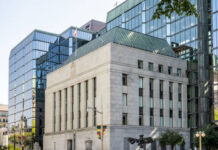Headlines
US stocks opened largely unchanged as investors sat on the side-lines ahead of a closely followed House of Representatives vote on a bill that would largely repeal and replace the Affordable Care Act, also known as Obamacare. European stock markets gain 0.2% to 0.5%.
UK retail sales beat expectations in February, rising 1.5% m/m ex. auto fuel after a 0.3% m/m decline in January. However, British retail sales in the 3 months to February recorded their biggest slide in nearly 7 years as higher fuel prices eroded shoppers’ disposable income. A drag on overall Q1 economic growth now looks all but certain.
Initial jobless claims rose by 15,000 to 258,000 in the week ended March 18, the Labor department said. It was the highest level since the week ended January 28 and above consensus (240,000). Meanwhile, continuing claims, a measure of the number of people claiming benefits, was little changed at 2m.
Purchases of new homes increased in February to a seven-month high, indicating the effects of the recent rise in borrowing costs on the US residential real estate market have been modest. Sales rose 6.1% to a 592,000 annualized pace.
EMU banks took up more free long-term loans than expected at the ECB’s final TLTRO auction as expectations grow that the era of free cash may be coming to an end. The TLTRO saw 474 banks borrow €233.5B over four years. It was also way more than in the previous three auctions, once the repayment of existing loans is taken out.
German Chancellor Angela Merkel’s conservatives would win more votes than the centre-left Social Democrats (SPD) if an election were to be held this Sunday, a survey showed, six months before a national vote in Europe’s political and economic powerhouse.
Rates
Bond markets in wait and see modus
Global core bonds hovered sideways in a tight range. The small intra-day movements of the Bund were inversely correlated with equities (EuroStoxx), which traded also in a tight range. Data had only a temporarily impact. The ECB TLTRO was a big success. At the time of writing, the German yield curve flattened with yield changes between +1.3 bps (2-yr) and -0.4 bp (30-yr). Changes on the US yield curve vary between -1.1 bps (2 & 30-yr) and -1.7 bp (5yr). On intra-EMU bond markets, 10-yr yield spread versus Germany narrowed 3 to 4 bps for both peripherals and semi-core bonds, helped by a strong TLTRO bidding (see below).
The EMU eco data, albeit not the most important ones, were a bid disappointing and shrugged off by the EMU bond market. German consumer confidence weakened a tad and March French business confidence fell short of expecations in some aspects. US initial claims jumped surprisingly higher, without the LBS reporting special factors. The only noticeable move up of US Treasuries started after the weak claims but didn’t carry far and gains were reversed after stronger than expected US New Home sales. It all came down to some volatility in a narrow sideways range.
The last TLTRO auction was a big success as banks asked a net €217.5 billion in 4-year liquidity, the largest amount asked since the start of the programme. The banks pay a rate between zero and -40 bps depending on the amount of their new lending to the real economy. The high demand was likely triggered by the fact that it was the last operation and by expectations that rates could go higher in the not too distant future.

Currencies
USD-indecisiveness persists ahead of healthcare vote
There was no clear story for USD trading. Indecisiveness prevailed as markets looked out whether the Trump administration would be able to set a first step to amend Obamacare. USD/JPY continues to trade with a tentatively negative bias (currently 111 area). At the same time, EUR/USD is locked in a tight range close to, but mostly slightly below 1.08.
Overnight, Asian equities traded slightly stronger, but the gains of both equities and the dollar remained modest. Amongst others, global investors were awaiting a first vote in the US house of representatives to repeal Obamacare. It is seen as a proxy to pass other fiscal legislation. USD/JPY hovered in the lower half of the 111 big figure.
The indecisiveness of the Asian markets persisted in Europe. Core bond yields showed no clear trend and changes in interest rate differentials were too small to guide currency trading. The dollar also showed a mixed picture. USD/JPY still traded with a negative bias even as European equities rebounded. Technical factors (end of quarter repositioning of Japanese investors) might be part of the explanation of current yen strength. At same time, EUR/USD also struggled to avoid further losses below the 1.08 big figure.
US jobless claims were higher (worse) than expected at 258 000. The data were probably only of second tier importance, but US markets kept a cautious attitude going into a potential vote on a new healthcare bill. The USD trends of this morning initially persisted, but the dollar profited slightly from better than expected US new homes sales. USD/JPY is trading in the 111 area, off the intraday low around 110.65. EUR/USD is still going nowhere just below 1.08 (currently 1.0780). The outcome of the health care vote (or the absence of a clear outcome) might tilt the USD balance in one way or another. For now, the euro shows little safe haven allure.

Sterling extends gradual rise after good retail data
Yesterday, sterling quite easily reversed a temporary decline after the terrorist attack in London. Sterling remained well bid and EUR/GBP traded with a slightly negative bias going into the publication of the UK retail sales. The ONS February retails sales (1.4% M/M and 3.7% Y/Y) were stronger than expected. Sterling rallied further after the publication of the report. EUR/GBP dropped to the low 0.86 area. Cable jumped to the 1.2525 area. However, sterling ran into resistance even as the CBI retail data (published at noon) also suggested decent retail activity in March. Even after better data in March, activity over the previous three months has slowed materially. We also have the impression that sterling is currently more sensitive to (better than expected) price data, rather than activity data. EUR/GBP trades currently in the 0.8615/20 area. Cable is changing hands in the 1.25 area. That said, the gradual post-BoE raise of sterling/decline of EUR/GBP remains intact.














